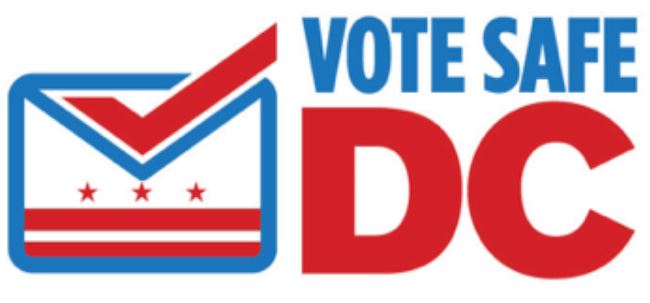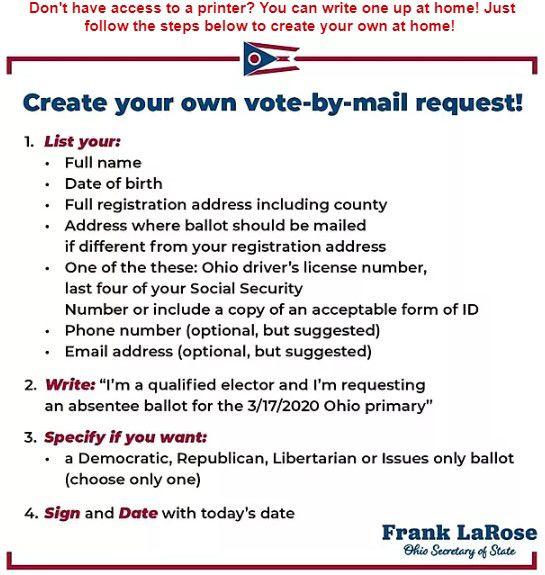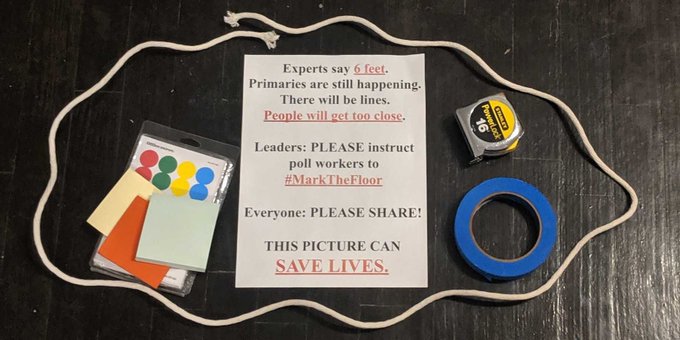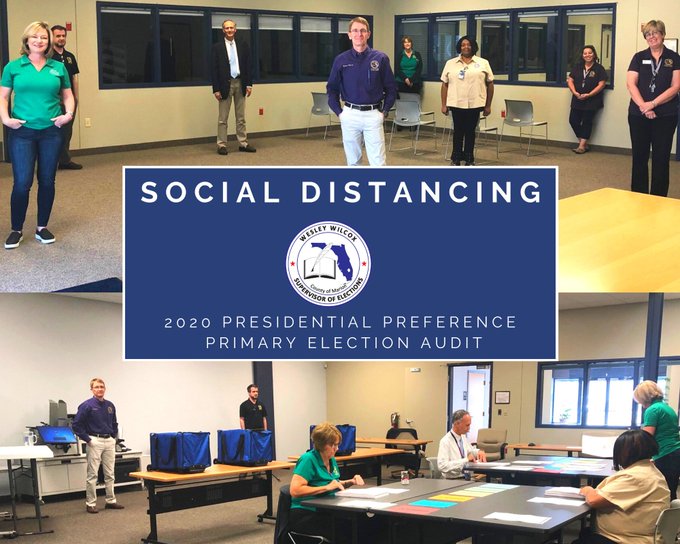39 Ways Election Offices are Responding to COVID-19
Across the country, election offices are adjusting the way they administer elections in response to the COVID-19 pandemic. Some of these changes are straightforward, like sanitizing polling places. Some are challenging, like pursuing legislative policy changes. And some are creative, like using library book drops to collect mail ballots.
We’ve broken these into 3 categories: Vote-By-Mail, In-Person Voting, and Your Elections Office.
We’ll keep this updated as election offices continue to respond in new, creative ways. What is your office doing?
Vote-By-Mail
1. Encouraging voters to vote by mail. Many states are strongly encouraging voters, if possible, to vote by mail. States with no-excuse absentee voting, like Georgia, are proactively mailing every voter an absentee ballot application. States that require excuses, such as Virginia, are encouraging people to check the “illness or disability” box on the absentee application. Some jurisdictions, like Erie County, New York, have explicitly included “public health emergency (COVID-19)” as an accepted excuse.
2. Expanding vote-by-mail infrastructure. States that can’t currently handle a dramatic increase in mail voting are working to expand vote-by-mail infrastructure. Several jurisdictions, like some Montana counties, are moving toward mail-only elections, which isn’t as feasible for states like Tennessee. Vote-by-mail can cause problems without strong infrastructure, such as sorting equipment, secure drop boxes, clear envelope design, a good relationship with USPS, signature verification processes, cure processes, etc. But don’t reinvent the wheel—resources include the Vote at Home Scale Plan, Center for Civic Design’s Toolkit of Designs for Scaling Up Vote-By-Mail, NASED’s collection of COVID-19 resources, and our 3 free webinars on vote-by-mail topics.
3. Requesting policy changes. Policymakers usually aren’t experts in election administration, so it’s important to ask for what you need. South Carolina election officials asked policymakers for no-excuse absentee voting, early voting, the ability to count ballots sooner, the ability to proactively mail voters ballots, and the removal of the witness signature requirement. North Carolina asked policymakers to allow mail ballot requests by fax, email, and through an online portal, to pre-pay postage on mail ballots, to reduce or eliminate the witness signature requirement, to allow counting mail ballots sooner, etc.
4. Conducting public outreach. D.C. launched a campaign called Vote Safe D.C. and even hired a public relations firm to help promote it. Mashpee, Massachusetts is exploring a reverse 911 call to inform residents how to request a mail ballot. Ohio created a promotional video from the Governor and Secretary of State.

5. Increasing drop boxes. Drop boxes are an easy way to limit in-person interactions when voters drop off their ballots. Wayne County, Ohio just got their first one. Arapahoe County, Colorado is adding 3 more, and asking the public for input on where they should go. We previously spotlighted the drop box system used in Pierce County, Washington.
6. Using library book drops. Madison, Wisconsin is partnering with the Madison Public Library to temporarily convert book drops into absentee ballot dropboxes. Libraries are already closed, so the book drops are being exclusively used for ballots. This is a fantastic, creative way to utilize existing resources.
7. “Don’t lick your envelope.” Many jurisdictions, such as Washington state, are reminding voters not to lick their ballot return envelopes. Washington actually does this during every virus season, not just coronavirus. Ada County, Idaho is going a step further and ordering stick-on envelopes that don’t require licking at all.
8. Expanding accessible options. In Orange County, California, an accessible vote-by-mail option for disabled and overseas voters has been expanded to anyone impacted by COVID-19. Voters can request an electronic ballot, mark it using their own assistive technology, then print and mail it.
9. Distributing ballot request forms widely. States like Ohio are letting voters request a ballot online and by phone, and even allowing voters to create their own form with any piece of paper. Since many voters don’t have access to a printer, Ohio is partnering with newspapers to include request forms that can be cut out and mailed in, partnering with grocers to distribute forms at grocery stores, and partnering with food banks to distribute forms at food drives.

10. Reaching voters without addresses. As North Dakota considers all-mail elections, Sioux County is partnering directly with the Standing Rock tribal community to ensure they can reach everyone, even voters without physical addresses. This is a particular challenge for Native Americans on reservations and voters in extremely rural areas.
11. Making postage free. Several states like Ohio are adopting ballot return envelopes with prepaid postage, and Douglas County, Kansas is prepaying postage for request forms as well. Idaho is getting creative by partnering with grocery stores that will provide free postage at service counters. As a failsafe, USPS is doubling down on the policy to deliver all ballots, regardless of postage.
12. Partnering with USPS. Reaching out to your local postal representative is highly recommended. Coordinating with USPS can help avoid the problems we’ve seen in Wisconsin around undelivered ballots and inconsistent postmarks. The local USPS representatives for Troup County, Georgia are making sure ballots with incorrect return addresses are delivered to the correct election office anyway. Delaware is partnering with USPS to implement mail ballot tracking. Our free webinar on Integrating low-cost tracking and reporting tools delves further into working with USPS, including resources like electionmail.org.
13. Capturing voter signatures. Hawaii is mailing every voter a signature capture card and asking voters to sign it and mail it back. Hawaii will then associate images of the signatures with each voter’s registration record. This will help with the signature verification process during the election, an important way to protect by-mail voting against fraud.
In-Person Voting
14. Postponing the election. At least 15 states and Puerto Rico have postponed their presidential primary elections. The decision to postpone (or not to postpone) has been controversial, sometimes attracting lawsuits.
15. Spreading out voters. Even when voters take social distancing seriously, it’s easy to bunch up when standing in line. Cook County, Illinois encourages poll workers to mark the floor in 6-foot increments using blue painter’s tape. Outside the polling place, Wisconsin recommends using sidewalk chalk to mark 6-foot increments. In Porter County, Indiana, a traffic control person will keep voters in their cars until they’re invited to join the line.

16. Limiting people in the room. In Benton County, Arkansas, only one person can vote at a time. D.C. is considering staggering access to polling places, possibly in alphabetical order by voter last name. In Nebraska, voters need to schedule an appointment to vote in person if they need accessible voting technology.
17. Sanitizing everything a voter touches. In Nebraska, every polling place will have hand sanitizer, disinfectant, individual pens that voters can keep, and masks and gloves for poll workers. Due to hand sanitizer shortages, Wisconsin partnered with local craft distilleries to produce alcohol-based hand sanitizer, and delivered the supplies by airplane to get them to clerks on time. Kenosha, Wisconsin is placing hand-washing stations at every polling place. Black Earth, Wisconsin is considering laying plastic wrap over voting booths, to be discarded after each vote. Jefferson County, West Virginia is considering using Q-tips for voters to use on touch screens—and other jurisdictions are using gloves, sandwich bags, a sanitized stylus, latex finger sleeves, plastic wrap, etc. In Santa Clara County, California, touch screens are sanitized with disinfectant wipes between each use.
18. Using masks for poll workers and voters. Missouri ordered a stockpile of more than 17,000 masks to be distributed to poll workers. But many jurisdictions are struggling to secure masks—which is why Cobb County, Georgia got creative and asked the public to donate homemade cloth masks. In D.C., voters themselves are required to wear a mask in order to vote in-person.
19. Using plexiglass separations. Jurisdictions like Montgomery County, Texas are using plexiglass screens to separate poll workers from voters. These can be built quickly and inexpensively by partnering with other government employees—Neenah, Wisconsin partnered with the city’s building maintenance crew, and Madison, Wisconsin partnered with the city’s Engineering Division.
20. Consolidating polling places. Consolidating polling places isn’t recommended, because we want to avoid crowded polling places. But poll worker shortages can be crippling—over 75% of poll workers in Anchorage, Alaska dropped out, and Wisconsin is facing a shortage of nearly 7,000 poll workers. Both jurisdictions are trying to cope by consolidating polling places.

21. Recruiting extra poll workers. Poll workers skew older and tend to be more vulnerable to severe cases of COVID-19. Understandably, many are declining to work this year, resulting in poll worker shortages. Scott County, Iowa has reached out to teachers’ groups and unions that may have workers idled by COVID-19 to recruit poll workers, and Montgomery County, Texas is utilizing county employees. Pennsylvania temporarily eased the requirement that poll workers must live in the precinct where they’re working. Porter County, Indiana is partnering with high schools to recruit 16- and 17-year-olds, who are now allowed more responsibilities than they previously were. Kansas is recruiting both high school and college students. Wisconsin is using members of the Wisconsin Army National Guard. In Maryland, the advocacy groups that lobbied for in-person voting have volunteered to help staff polling places themselves. Jurisdictions in Nebraska can legally draft poll workers (similar to jury duty), but they’re hopeful this won’t be necessary—instead, they’re incentivizing volunteers by clarifying that poll worker pay won’t reduce unemployment benefits, and promoting a charitable option similar to Orange County’s Adopt-a-Precinct program.
22. Training poll workers virtually. Normally, hands-on poll worker training is a great way to prepare for Election Day, but the COVID-19 risk is prompting jurisdictions like Erie County, Pennsylvania to cancel their in-person training. We’ve previously spotlighted the training videos from Sussex County, New Jersey and the interactive online slideshows from Arlington County, Virginia. We’ve also published a list of affordable online training resources.
23. Reacting to poll worker outbreaks. It’s the nightmare scenario—six days after the election, a Duval County, Florida poll worker started showing symptoms. The poll worker immediately alerted their election official and tested positive for COVID-19. Duval County notified the 360 voters who visited that precinct.
24. Avoiding vulnerable polling places. Jurisdictions like Ada County, Idaho are moving polling places out of any senior or assisted living homes, due to the increased risk to that population. Lancaster County, Nebraska is relocating polling sites from retirement communities. Statewide, Ohio relocated polling places from senior homes and delivered mail-in ballots directly to residents.
25. Using larger polling places. The larger the polling place, the more voters and poll workers can spread out. Marshall, Wisconsin is using a spacious polling place that’s normally only used for big elections. Maricopa County, Arizona is publicly calling on shopping center owners, professional sports franchises, and other large institutions to offer up their large spaces.
26. Using outdoor polling places. Wisconsin released guidance that polling place operations can be moved outside to help maintain proper social distancing and ventilation. Shawano, Wisconsin plans to do this, and voters will cast their ballots in large tents in the City Hall parking lot. They have a backup plan in case of bad weather.
27. Drive-up and drive-thru voting. Both Ignacio and Bayfield, Colorado are offering drive-up voting, where voters can complete their ballots inside their vehicle. Conway, New Hampshire is considering using a kiosk and a large parking lot, so voters can receive their ballot, park, and fill it out. Bristol, Virginia actually has a drive-thru window, thanks to the building’s previous owners. Vernon County, Wisconsin constructed a mobile voting shed for drive-up voting.

Your Elections Office
28. Working from home. Across the country, whenever possible, elections staff are working from home. Minneapolis has been tweeting pictures of work-from-home setups every day for over a week! (Thurs, Fri, Mon, Tues, Weds, Thurs, Fri).
29. Staggering office shifts. In Riverside County, California, half of the election staff comes into the office every other day, taking turns working from home. This makes it possible for staff members to spread out and observe the 6 feet of social distancing. In Porter County, Indiana, half the staff works Monday through Wednesday afternoon, and the other half works Wednesday afternoon through Friday.
30. Reconfiguring your office. In Oregon, Multnomah County and Marion County both plan to reconfigure seating so that staff are not seated next to each other.
31. Closing to the public. Many offices, like Seminole County, Florida, are closed to the public and redirect communications to their website, phone, email, mail, and a dropbox outside their office. Unavoidable in-person interactions are by appointment only. Some offices aren’t fully closed, like New Hanover County, North Carolina, which requires visitors to get their temperature taken before entering.
32. Holding virtual meetings. Shelby County, Tennessee is holding meetings electronically and letting the public dial in, and Kentucky is using video conferences for Board of Elections meetings. If you’re new to this, we have some tips for you. And take steps to prevent “Zoombombing,” when an uninvited person joins your meeting and causes disruption. This happened in Milwaukee, Wisconsin, when pornographic images and racial slurs interrupted an Election Commission meeting.
33. Live-streaming election processes. Union County, New Jersey is live-streaming their ballot position drawing on Facebook, Ottawa County, Michigan is live-streaming their logic and accuracy testing, and Maryland is live-streaming the counting of ballots.
34. Finding alternate sources for staffing. Poll workers aren’t the only workforce that skews older. Many of the temporary staffers that process mail ballots and canvass the votes are similarly vulnerable to COVID-19 and may decline to work this year. Multnomah County, Oregon is recruiting county employees who have been idled by the shutdown, instead of relying exclusively on their usual recruitment pool.
35. Processing ballots carefully. In Stamford, Connecticut, the workers who open thousands of mail ballot envelopes take a break every 10 minutes to wash their hands. This helps prevent “viral load,” especially since envelopes may have been licked. Utah is considering quarantining ballots before processing them, just like they’re already doing with candidate signature packets.
36. Delaying certification deadlines. Marion County, Oregon will have reduced staffing in order to maintain six feet of distance between workers, so they’re looking for a way to delay the certification deadline. Yolo County, California managed to delay their certification deadline by one week, also due to staffing issues. Jurisdictions in West Virginia are able to delay certification if needed.
37. Expanding online voter registration. Luckily most states already offer online voter registration, relieving some strain on in-person interactions. North Carolina partnered with their DMV to expand online voter registration to anyone with a North Carolina driver’s license, whereas previously the service was only available during online DMV transactions.
38. Social distancing during post-election audits. Public trust in the government is especially important during times of uncertainty, and post-election audits are a great way to bolster public trust. Marion County, Florida conducted a post-election audit while social distancing to protect election staff. You can also maintain social distancing while taking our online, self-paced courses on post-election audits!

39. Brushing up cybersecurity knowledge. State-level staff from North Carolina are taking or retaking cybersecurity training, since phishing attempts and other cybersecurity risks may be higher during the COVID-19 response period, and have requested that county-level staff do the same. Our online, self-paced cybersecurity courses are a great way to brush up on cybersecurity while working from home.
What else are you doing?
We know this list isn’t exhaustive. Your creativity and determination are always impressive, and especially now. We’d love to hear what your office is doing! Email [email protected], or answer our 1-question survey.